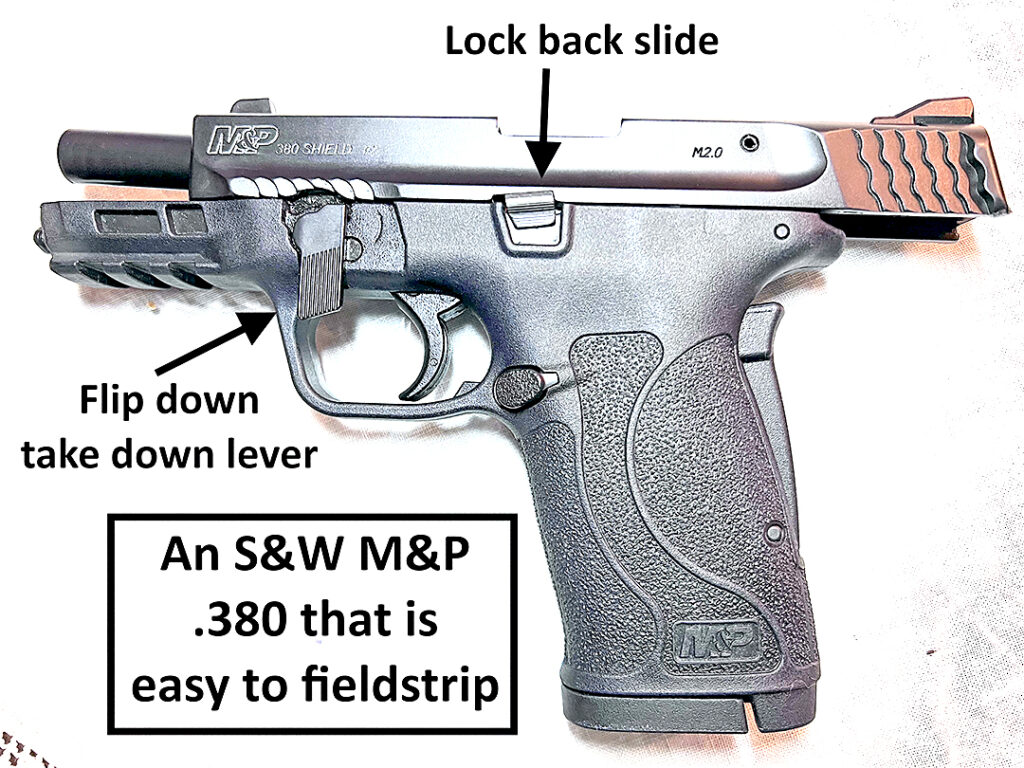The older shooter and how to cope, Part 3


We’ve discussed how to make shooting easier for the mature shooter. Sad truth is, as we age we lose muscle strength and range of motion, our eyesight changes, arthritis sets in… But we still want to target shoot! We still want to be able to defend ourselves! What can make a difference so that shooting is easier for us?
In the last two issues of The Wakulla Sun, we talked about the Marine saying: “Improvise, adapt, overcome.” This philosophy works well with choosing and handling our guns.
Many things can make a difference including having handguns with: low recoil, comfortable weight and length, easy-to-rack slides, easy loading, easy-to-see sights, easy trigger pull, and having comfortable grips. The Sun keeps back issues if you’d like to review these articles.
Let’s consider other issues that will help ease your shooting life.
No matter what kind of gun you have, it will have to be cleaned. Dirty guns with lots of shooting residue can fail. Big problem? You bet! When you have to defend your life, you want to be certain your gun is in top shape. Will you be able to “fieldstrip” your gun so that you can clean it?
Joe has a couple 1911-style handguns. John Moses Browning, born in 1855, engineered the 1911s and they have been widely used for around 100 years. Widely used? Yes. Easy to take down to clean? No. Would Joe give up his 1911s for easier to clean guns? No. Would I purchase a 1911? No. Too much work.
Cleaning a .380 caliber or 9mm handgun? Some have notches in slide and frame that have to be aligned before taking the slide off the frame. When perfectly aligned, a pin connecting the two can be pushed out. This is not as simple as it seems. Again, perfect alignment can be too exacting. Too much work.
You don’t have to be old or decrepit to appreciate a gun that’s easy to fieldstrip. Many new guns have “take down” levers. Lock the slide back, then flip the take down lever and pull the slide off the gun. Easy. I like easy. Now you can clean your gun. So, before you buy, find out how easily the gun comes apart.
Some kinds of ammunition are harder to shoot than others. Defensive loads give a much harder recoil, such as the hollow-point, +P, or +P+. Also, remember to check your manual because not all guns can handle these rounds.
Practice acquiring muscle memory with target loads instead. (It doesn’t hurt that target loads are cheaper.) Put in defensive rounds when you are carrying for your safety, but use the less expensive target loads when you’re at the range trying to pick out the x-ring.
How do you expect to carry your gun? How have you been carrying it?
Physical ramifications of age may dictate how you carry. If you’ve been carrying the gun at your waist on your dominant hip side, you may want to rethink this.
Shoulders with problems may make it too difficult to pull your gun straight up from its holster. Instead, cross-drawing may be easier on you. Of course, there’s a learning curve here. Practice drawing in this new position with an empty gun so you won’t accidentally hit the person next to you.
Another choice is to wear a shoulder holster and draw from it. Again, it’s time to practice this new position for your safety and for the safety of others.
Finally, I’d like to talk about vision.
Have you noticed that mature people often wear glasses? Most articles I’ve read suggest that you should shoot looking at your target with both eyes. If your eyes usually need assistance, your eye doc can make up prescription glasses for shooting. Even better, ask for glasses with a light-yellow tint on them. This tint somehow improves definition of what you’re viewing.
Truthfully, I squeeze one eye shut while shooting. It works for me. Try looking straight on and try squeezing one eye shut. Whatever works best for you. So long as you don’t squeeze both eyes shut. (ahem)
Massad Ayoob, on the Wilson Combat YouTube channel, discusses tips for the older shooter and has tips for those who wear bifocal lenses.
First, Massad shows how a person with bifocals will look at the front sight. The reading plane of bifocals is the lower part of the glasses. In order to see that front sight, one has to look through this bottom part of the glasses. This makes the shooter have to lean backwards and the resulting position now puts the shooter off balance as well.
To correct this problem, Massad suggests visiting an optician and asking the optician to switch the two parts of the glasses so that the reading portion is on top. This way, the top of the lens is on the same plane as the front sight.
Of course, when you want to read a book or newspaper, you’ll now be reading from the top of your glasses, which will tilt your head downward. Is this too awkward?
Alternately, can you afford to keep your original glasses and buy another pair with the switched lenses just for practice at the range? And if you do have 2 pair, which will you be wearing if you are ever in the position of being afraid for your life? Will muscle memory from range practice place your bullet correctly?
I’m on the fence on this one, but it’s worth considering if I ever need to wear bifocals.
If you are fortunate enough to become an old person, shooting may be a sport where you’ll have to learn to improvise, adapt, and overcome to adjust to your physical needs.
With a little creativity, it’s never too late.
Marj Law is the former director of Keep Wakulla County Beautiful who has become an avid shooter in retirement.


